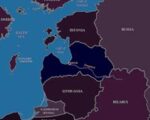In response to escalating Russian drone activity near NATO’s eastern flank, the United Kingdom has deployed Royal Air Force (RAF) Typhoon fighter jets to Poland as part of a reinforced NATO Air Policing mission. The move underscores growing concern over airspace integrity following multiple incidents of Russian unmanned aerial vehicles (UAVs) violating or approaching Polish territory during operations in western Ukraine.
Deployment Details and Operational Context
The RAF deployment comprises Eurofighter Typhoon FGR4 multirole combat aircraft from No. XI(F) Squadron based at RAF Coningsby. These aircraft arrived at the 22nd Tactical Air Base in Malbork, northeastern Poland, in early September 2025 under Operation Azotize—a recurring UK contribution to NATO’s enhanced air policing efforts on the Alliance’s eastern borders.
According to the UK Ministry of Defence (MoD), the Typhoons will conduct Quick Reaction Alert (QRA) duties alongside Polish and other allied aircraft. Their primary role is to intercept and identify any unauthorized or suspicious aerial activity approaching or entering NATO airspace. The deployment is expected to last several weeks and includes support personnel and logistics elements from the RAF’s Expeditionary Air Wing structure.
Russian Drone Incursions Prompt Heightened Vigilance
The decision follows a series of incidents involving Russian UAVs—primarily Orlan-10 reconnaissance drones and Shahed-type loitering munitions—straying into or crashing within Polish territory. Notably:
- In December 2023, a suspected Russian missile crossed into Polish airspace during a mass strike on Ukraine before crashing in a forest near Bydgoszcz.
- In April 2024, debris from an unidentified UAV believed linked to Russian operations was discovered near Zamość.
- In August 2025, Polish authorities reported two separate instances of UAV radar tracks briefly entering its air defense identification zone (ADIZ).
While Warsaw has refrained from direct military retaliation, it has repeatedly condemned these violations as dangerous provocations. The presence of RAF fighters adds both deterrent value and rapid interception capability should future incursions escalate.
NATO Integrated Air Defense Posture
This deployment forms part of NATO’s broader Integrated Air and Missile Defence System (NATINAMDS), which coordinates sensors, command-and-control nodes (C2), and interceptor assets across member states. In recent years—particularly since Russia’s full-scale invasion of Ukraine in February 2022—the Alliance has significantly bolstered its eastern flank posture through rotational fighter deployments and enhanced surveillance coverage via AWACS and ground-based radars.
The Malbork base is strategically located just ~80 km from the Kaliningrad exclave—a heavily militarized zone hosting Russia’s Baltic Fleet assets along with S-400 SAM systems and Iskander-M tactical ballistic missiles. As such, allied QRA units operating from this location must maintain high readiness against potential electronic warfare interference or GPS spoofing attempts originating from Kaliningrad-based systems.
Typhoon Capabilities Relevant to the Mission
The Eurofighter Typhoon FGR4 is well-suited for this type of deterrence operation due to its high-speed interception profile (Mach 1.8+), advanced AESA radar (Captor-E), IRST sensor suite (PIRATE), and Link-16 datalink integration for networked situational awareness. For this mission set:
- The aircraft are typically armed with AIM-120C-5 AMRAAMs for beyond visual range engagements and AIM-132 ASRAAMs for close-in dogfighting.
- A targeting pod such as Litening III may be carried for ISR support if required.
- Electronic countermeasures include DASS self-protection suite with RWR/MAWS/chaff-flare dispensers.
The RAF has also invested in synthetic training environments that allow pilots deploying on such missions to rehearse intercept scenarios involving slow-moving drones or cruise missiles—threat types increasingly prevalent along NATO’s periphery.
Strategic Implications for Regional Security
This latest deployment reflects not only tactical response but strategic signaling by London toward both allies and adversaries. By contributing high-readiness assets under NATO command structure rather than bilateral arrangements alone, the UK reinforces collective defense principles enshrined in Article V while demonstrating operational interoperability with frontline states like Poland.
Moreover, it complements other ongoing efforts such as:
- NATO Baltic Air Policing rotations out of Šiauliai AB (Lithuania) and Ämari AB (Estonia).
- The US-led Integrated Battle Command System trials integrating Patriot batteries across Romania/Poland/Germany corridors.
- Czech Gripen deployments supporting Slovakian air sovereignty post-MiG retirement.
As hybrid threats—including jamming attacks on GNSS signals used by civilian aviation—continue rising along the Suwałki Gap corridor between Belarus and Kaliningrad Oblast, forward-deployed QRA fighters remain a key pillar of deterrence posture in Central Europe.
Conclusion
The arrival of RAF Typhoons in Poland marks another step toward reinforcing NATO’s eastern shield amid persistent gray-zone provocations by Russia using drones and other asymmetric means. While not intended as an escalatory measure, their presence provides critical reaction time against airborne threats while reassuring frontline allies that collective defense remains credible—and airborne—24/7 over Europe’s most contested skies.








